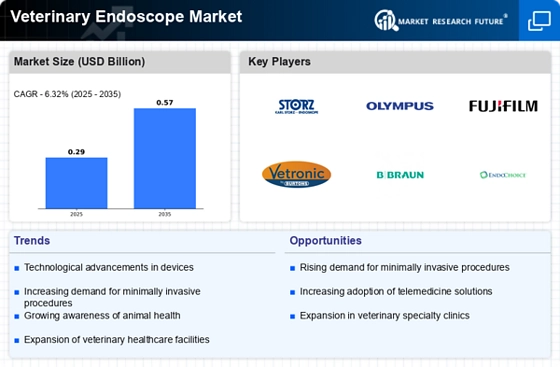Growing Awareness of Animal Health and Wellness
The Veterinary Endoscope Market is benefiting from the growing awareness of animal health and wellness among pet owners. As education regarding animal care increases, pet owners are more informed about the importance of regular health assessments and the role of advanced diagnostic tools. This heightened awareness is leading to a greater acceptance of endoscopic procedures as a viable option for diagnosing and treating various conditions in pets. The Veterinary Endoscope Market is likely to see an uptick in demand as more pet owners seek out veterinary practices that offer these advanced services. This trend suggests a shift towards a more proactive approach to animal health, further driving the growth of the market.
Rising Pet Ownership and Spending on Veterinary Care
The Veterinary Endoscope Market is experiencing growth driven by the rising pet ownership rates and increased spending on veterinary care. Recent statistics indicate that pet ownership has surged, with approximately 70% of households owning at least one pet. This trend correlates with a heightened willingness among pet owners to invest in advanced medical care, including endoscopic procedures. The average expenditure on veterinary services has also seen a significant increase, with pet owners spending an average of 1,500 to 2,000 annually on their pets' health. As more pet owners seek specialized diagnostic tools, the Veterinary Endoscope Market is likely to benefit from this growing consumer demand, leading to further innovations and enhancements in veterinary endoscopy.
Regulatory Support and Standards in Veterinary Practices
The Veterinary Endoscope Market is positively impacted by the establishment of regulatory support and standards in veterinary practices. Regulatory bodies are increasingly recognizing the importance of advanced diagnostic tools, including endoscopes, in ensuring high-quality veterinary care. This recognition has led to the development of guidelines that encourage the adoption of endoscopic procedures, thereby enhancing the overall standard of care. Furthermore, compliance with these regulations often necessitates the use of modern equipment, which drives demand within the Veterinary Endoscope Market. As veterinary practices strive to meet these standards, the market for endoscopic devices is likely to expand, fostering innovation and improving animal health outcomes.
Increased Focus on Preventive Care in Veterinary Medicine
The Veterinary Endoscope Market is significantly influenced by the growing emphasis on preventive care within veterinary medicine. Pet owners are increasingly seeking regular health check-ups and screenings for their animals, which often necessitate the use of endoscopic procedures. This trend is reflected in the rising number of veterinary clinics offering preventive services, which has been reported to increase by over 15% in recent years. As veterinarians prioritize early diagnosis and treatment, the demand for endoscopic tools that facilitate these processes is expected to rise. Consequently, the Veterinary Endoscope Market is poised for expansion as practices integrate preventive care into their service offerings, ultimately enhancing animal health outcomes.
Technological Advancements in Veterinary Endoscope Market
The Veterinary Endoscope Market experiences a notable surge due to rapid technological advancements. Innovations such as high-definition imaging, flexible endoscopes, and minimally invasive techniques enhance diagnostic capabilities. The integration of artificial intelligence and machine learning in endoscopic procedures is also gaining traction, potentially improving accuracy and efficiency. According to recent data, the market for veterinary endoscopes is projected to grow at a compound annual growth rate of approximately 7.5% over the next five years. This growth is driven by the increasing demand for advanced diagnostic tools that facilitate early detection of diseases in animals. As veterinary practices adopt these cutting-edge technologies, the Veterinary Endoscope Market is likely to witness a transformation in how veterinary care is delivered.


















Leave a Comment